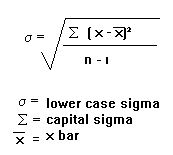

Standard Deviation

Lower case sigma means 'standard deviation'.
Capital sigma
means 'the sum of'.
x bar means 'the mean'
The standard deviation
measures the spread of the data about the mean value. It is useful in comparing
sets of data which may have the same mean but a different range. For example,
the mean of the following two is the same: 15, 15, 15, 14, 16 and 2, 7, 14, 22,
30. However, the second is clearly more spread out. If a set has a low standard
deviation, the values are not spread out too
much.
Example:
Find the standard deviation of 4, 9, 11, 12, 17,
5, 8, 12, 14
First work out the mean: 10.222
Now, subtract the mean
individually from each of the numbers in the question and square the result.
This is equivalent to the (x - xbar)² step. x refers to the values in the
question.
x
4
9 11
12 17
5 8
12 14
(x -
x)² 38.7 1.49 0.60 3.16
45.9 27.3 4.94 3.16 14.3
Now add up these
results (this is the 'sigma' in the formula): 139.55
Divide by n-1. n is the
number of values, so in this case is 8: 17.44
And finally, square root this:
4.18
The standard deviation can usually be calculated much more
easily with a calculator and this is usually acceptable in exams. With some
calculators, you go into the standard deviation mode (often mode '.'). Then type
in the first value, press 'data', type in the second value, press 'data'. Do
this until you have typed in all the values, then press the standard deviation
button (it will probably have a lower case sigma on it). Check your calculator's
manual to see how to calculate it on yours.